Yingko/iStock/GettyImages
Metals such as aluminum and copper are widely used in pots and pans because they're excellent conductors of heat. Cast iron is cherished by cooks for precisely the opposite reason. Although it takes a long time to heat, when it reaches the correct cooking temperature it will retain that heat unusually well. That's why cast iron skillets work so well for chops or pancakes, and enameled cast iron roasters and Dutch ovens make excellent roast chicken.
Enameled Cast Iron
Cast iron is both exceptionally durable and painfully easy to damage. When well cared for, a piece of cast iron cookware can outlast generations of cooks, but rust and misuse can reduce a pan to scrap in just a few years. Many manufacturers protect their cookware from misuse by coating it with colorful enamel. The enamel coating preserves the iron and simplifies cleanup. It also protects foods from the discoloration that cast iron can sometimes cause in tomato-based sauces and other acidic foods.
Adjusting to Cast Iron
Enameled cast-iron Dutch ovens and roasters are made by many companies, from legendary French and German manufacturers to new brands created for TV celebrity chefs. Either a Dutch oven or a roaster can be used to roast a chicken. The rounder shape of most Dutch ovens allows space to roast vegetables around the chicken, if you wish. The heavy cast iron takes much longer to heat than lightweight roasters, but the heat then radiates evenly from the bottom and sides. To take advantage of those characteristics, most recipes advise high-temperature roasting.
Preparing to Roast
Prepare your chicken as you normally would. If your recipe calls for brining, remove the bird from the brine and pat it dry before you place it in the roaster. Cast iron roasters and Dutch ovens seldom come with a roasting rack, so improvise one with a cooling rack or trivet if you can. If not, coarsely chop onions, celery and carrots and use those to make a cushion for the bird to rest on. Cut off the wingtips or tuck them underneath. The chicken's breast meat will cook more quickly than the thighs, so place a halved lemon or onion, or a ball of foil, inside the cavity to impede the hot air. Brush the chicken's skin with oil or melted butter, if you like it especially crisp.
Roasting Your Chicken
Preheat your oven to 450 degrees Fahrenheit, and put in the chicken. After 15 minutes, when the roaster is well heated, reduce your cooking temperature to 350 F. A normal-sized chicken, at 3 1/2 to 4 pounds, will need approximately 45 more minutes at the lower temperature to be fully cooked. A meat thermometer inserted into the thickest part of the thigh should read 165 F when it's done. If the chicken went straight from your refrigerator to the roaster it can take up to an additional 15 minutes, so trust your thermometer more than the timing. The heavy pan will keep cooking the chicken, so remove it immediately to a serving tray. Cover the bird loosely with foil and let it rest at least 10 minutes before carving for the juiciest result.
Related Articles
How to Cook Chicken Pieces in an ...

Can You Cook Bone-in Chicken in a Metal ...

How to Broil Chicken on the Bone

How to Make Blackened Chicken

How to Cook a Chicken in a Toaster Oven ...

How to Cook a Flat Chicken
How to Cook in Tabletop Convection Ovens

Can You Roast Whole Frying Chickens?

How to Cook Chicken Bratwurst

The Best Ways to Make a Baked Moist and ...
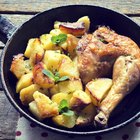
How to Sear and Bake Chicken
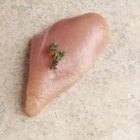
How to Cook Boneless Chicken Breasts in ...
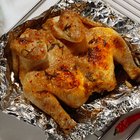
How to Get a Crispy Crust on Roasted ...

How to Marinate BBQ Chicken Thighs & ...
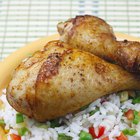
How to Roast a Chicken Leg
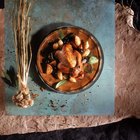
The Best Way to Cook Cornish Hens
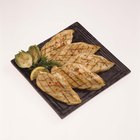
How to Cook Boneless Chicken Breasts to ...
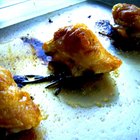
How to Cook Chicken Thighs

Difference in Cook Time Between Bone-in ...

How to Cook Sauteed Chicken With White ...
References
- On Food and Cooking: The Science and Lore of the Kitchen; Harold McGee
- USDA Food Safety and Inspection Service: Chicken from Farm to Table
Writer Bio
Fred Decker is a trained chef and prolific freelance writer. In previous careers, he sold insurance and mutual funds, and was a longtime retailer. He was educated at Memorial University of Newfoundland and the Northern Alberta Institute of Technology. His articles have appeared on numerous home and garden sites including GoneOutdoors, TheNest and eHow.